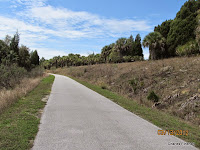The Withlacoochee Bay Trail at 10201 N Suncoast Blvd. in Crystal River Florida, and runs 5 miles west from the Felburn Park Trailhead to the Gulf of Mexico along the southern side of the former Cross Florida Barge Canal. The 12 foot wide multi-use paved trail runs adjacent to the barge canal for the first 2.5 miles and then winds to the left, and the berm that was created by the canal’s excavation will run along your right. The westernmost 2.5 miles of the trail runs through maritime hammocks and salt marsh.
My visits were 3-13-12 and 8-9-12. Parallel to the paved trail from Felburn Park a vehicle access road runs from the US 19 bridge west for almost five miles. This road provides access to the numerous multi-use platforms that are situated along the canal and the marsh to the south of the road and paved trail. There are three places to park and unload your bike on this road. The last one is the best, where there is a rest room and picnic shelter on the canal. You will be about two miles from the west end of the trail. A really fantastic starting point if you choose. Be prepared there is no running water along the trail, only at the Felburn Park trailhead. The platforms are suited for nature observation, picnicking, fishing or just enjoying the great outdoors. At the westernmost end of the access road a parking area and canoe/kayak launch are available on the south side of the paved trail.
This is a really nice trail to bike. I enjoyed it a lot. The shelters along the water are huge, perfect for having a picnic or just relaxing. Gopher tortoise and armadillo sightings are common, which is always a treat. Towards the end of the trail on your left, it will become swamp and marsh. You will soon start seeing the Crystal River Power Plant off in the distance. A little farther down there is a large shelter with a short boardwalk that will give you a better view. You will notice the two huge stacks. When built in 1977, this was a nuclear power plant. However in 2009 workers cracked the 42-inch thick concrete containment building, which led to the plant being shut down. However it is pretty cool to see the plant. It is now owned by Duke Energy.
The Withlacoochee Bay Trail extension was finished around the end of July 2012, running east of the Felburn Park trailhead. I was fortunate to document my ride here on 8-9-12. It extends only 1.2 miles (one way), has thick vegetation along both sides, and a small scenic lagoon with steep rock sides on the north side of the trail. There is also very little shade along this new section, and people have reported seeing a bobcat on numerous occasions. While all paved trails are a treat to ride and enjoy, this one was nice but nothing super special. My videos from the Withlacoochee Bay Trail are below.
A BRIEF HISTORY ON THE FLORIDA BARGE CANAL
Between 1909-1913 the Army Corp of Engineers were commissioned to survey and evaluate if building a canal across Florida would be beneficial. They said no. However state and federal politicians wanted it built. So in 1935 FDR allocated 5 million to start construction. The canal was to be 171 miles long, 30 feet deep, and 250 feet wide. However in 1936 Congress defunded the project.
Then in 1964, probably due to extreme political pressure, President Johnson signed the bill to start building the canal again. The damage from the construction and exacavation was massive. In the mid to late 60's extreme pressure from environmenalists aided by the media caused Washington to second guess the canal project.
Finally in 1970 the U.S. Interior Secretary recommended a halt to building pending another study. This time the Army Corp of Engineers fought to keep the project going. Then at the end of 1970 Nixons environmental council recommended stopping the project. In January of 1971 the U.S. District Court ordered the canal project halted. Four days later Nixon sided with the court. 28% of the canal was completed.
As you can see giant pylons are still here from the Florida Barge Canal project. In the 1990's the Florida EPA assumed control of the project and land. Today this 110 mile corridor traverses a wide variety of natural habitats and offers a variety of trails and recreation areas where visitors can experience the wonders of Florida in their own recreational style.











